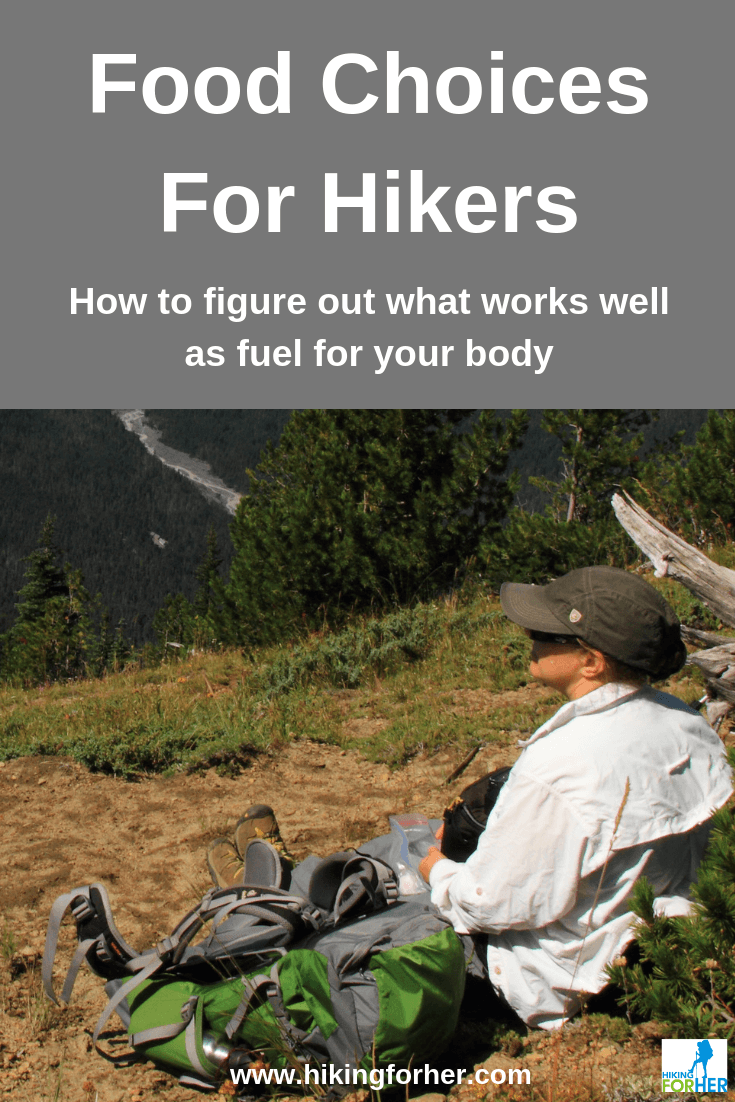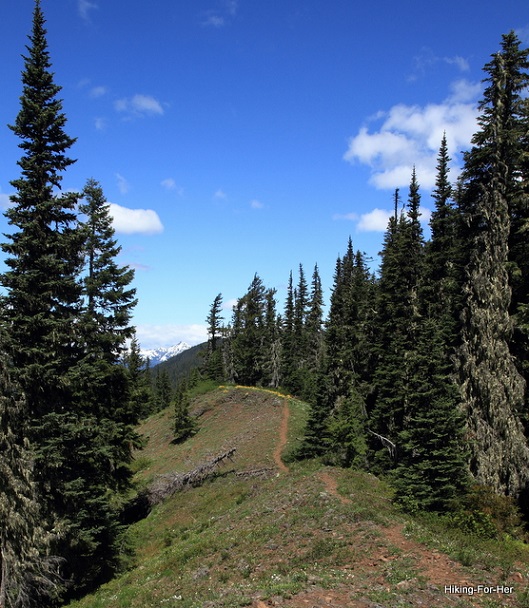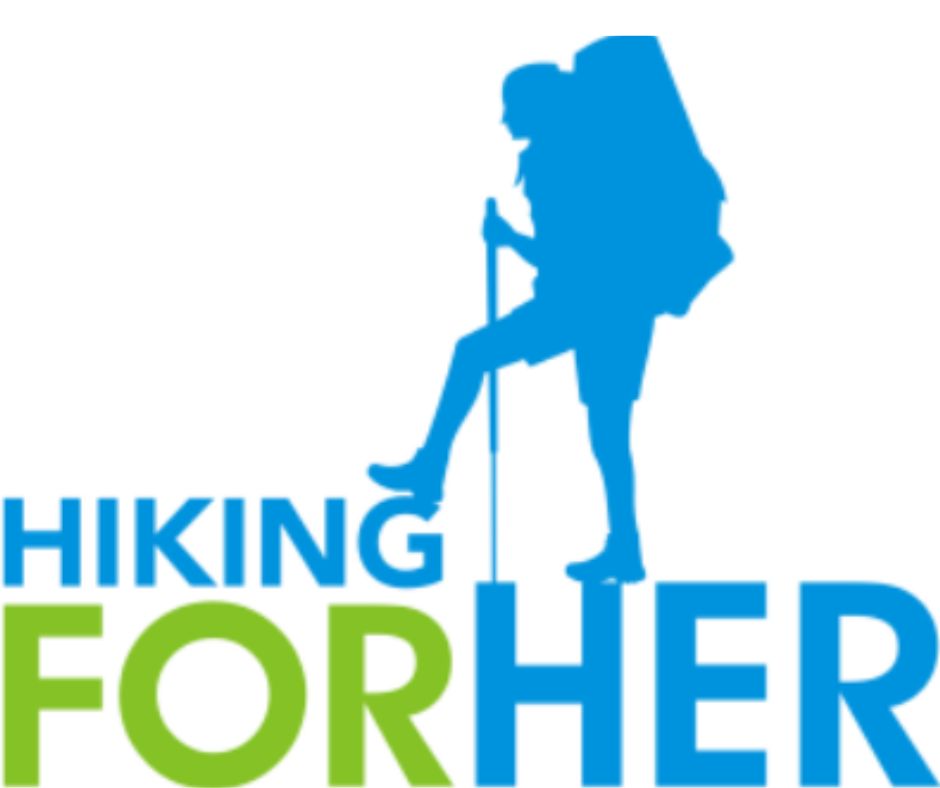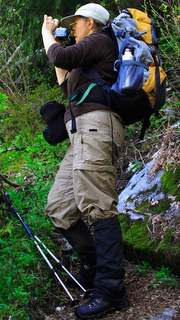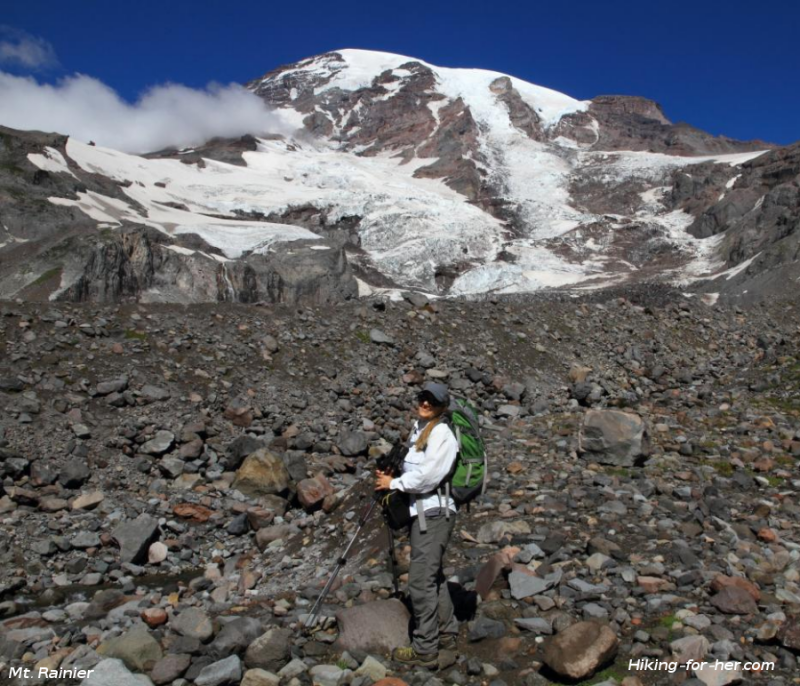Enjoy Happy Trails, the free monthly newsletter from Hiking For Her
Receive a free resource: "Hiking Layering System Explained"
Hiking Nutrients:
How To Choose Your Trail Food
By Diane Spicer
Choosing hiking nutrients seems pretty straightforward:
- carbohydrates, proteins and fats
Just grab a bunch of lightweight food and hit the trail.
Simple as that, right?
Then chew, swallow, and you're good to go.
Except it's a little more complicated
than that
Hikers, like soldiers, march on their stomachs.
High quality, digestible food which is quickly and easily absorbed into the bloodstream to provide sustained energy along the trail (aka fuel) is the secret to successful hiking adventures.
OK, only one of the secrets.
The rest are here on other pages of this website, so be sure to browse around!
- The search box at the top of every page will always be waiting for you.
Now add in your uniqueness
And here's another little fact you've probably already discovered: your gut is unique and has its own little foibles and preferences.
- Too much protein at one go, and you manufacture alarming amounts of gas.
- Eat the wrong combination of protein and fats, and you're in for a long, painful night.
- Gorge on carbs and bloat up like a balloon.
Go ahead and fill in the picture with your own particular scenario(s).
Which leads to this important question about the best hiking food for your plans.
Are you digesting
the hiking nutrients
you swallow?
So if hiking nutrients are the key to a strong hiking body (and they are), how do you maximize your digestive abilities? (i.e. burn fuel efficiently)
And what clues should you expect to see when your digestive system is not operating efficiently?
To answer those questions, let's take a quick look at the digestion process.
No boring science stuff, I promise.
Your hiking nutrient digestion begins in your mouth, at least for certain types of food such as sugars (carbohydrates).
A simple example
Visualize a toddler gumming a cracker.
- The long stringy saliva
covering the child's shirt is full of digestive enzymes for the starches
(storage form of carbohydrates, or sugars) in the cracker.
- Our future hiker is already absorbing some of the nutrients (fuel) from the cracker, simply by gnawing and drooling on it.
But if the cracker had a little peanut butter, cheese or salami (protein and fat) on it, that's a whole different story.
- Once the cracker is chewed and swallowed, the stomach has a few enzymes to begin protein digestion, but not for the fats.
So fatty food passes undigested through the stomach into the small intestine.
That's where things get ugly,
if you're a protein or a fat molecule
Digestive enzymes pour into the small intestine - they're made by the nearby pancreas, and released only when needed.
The large biomolecules in the peanut butter, cheese and salami are chopped into tiny pieces by the enzymes, and hauled out of the intestine into the bloodstream.
It's only fair to give a nod to the liver and gallbladder here, too.
- The liver makes bile, while the gallbladder stores it.
- Bile waits until it's needed for emulsifying fats.
- Emulsification is a fancy way to say chopping big fat globules into tiny pieces, giving lots of surface area for digestive enzymes.
- Lots of surface area is a good thing! You want to hang onto those precious fuel molecules (digest) and send them (absorb) to locations far flung from the intestines.
Once digested,
where do hiking nutrients go?
Where do your digested (as in "chopped up") sugars, fats and proteins go once they leave your intestinal tract?
Into the bloodstream, for swift delivery to all of the cells in the body.
They are fuel sources (like gas in your car's tank), which every cell is going to use.
Hiking nutrients, in other words.
Let's get specific about
hiking nutrients
Proteins are used to repair injured areas of the body, or to make DNA molecules or other important things to keep your cells humming along.
- You don't want to use your proteins as fuel sources unless you really, really have to (chopping up your skeletal muscles doesn't sound like a good idea for a backpacker, does it?)
Best choices for hiking protein are outlined here.
Fats (a.k.a. lipids) have two fates: immediate use for fuel (fatty acids), or storage for later needs (adipose).
Carbohydrates (sugars) are burned immediately as a fuel source, or can be stored in skeletal muscle or liver.
- Hikers should have lots of stored carbohydrates (glycogen) in these organs, because that helps to keep us going between meals.
Great carb choices for hiking are found here.
Sometimes things
can go wrong
For example: if the hiking nutrients are NOT chopped into little pieces, or CAN'T be pulled into the bloodstream.
How would you know that digestion is not happening correctly to provide you with hiking nutrients?
- Maybe you wouldn't know :(
In which case, you're in a honeymoon phase.
But sooner or later, if there's an underlying problem (not enough digestive enzymes, or an imbalance between your normal gut microbiota and intruders) your body sends your brain a "postcard" about lack of hiking nutrients.
These postcards can include little messages written as:
- fatigue,
- gas and bloating,
- long post-hike recovery times,
- frequent infections,
- inflammation
You know, the fun stuff (NOT!) regarding hiking nutrients and digestion.
Or maybe little clues are showing up elsewhere.
Like in the toilet bowl.
Do I really have to look??
One of your best clues to digestive problems is the quality of your stool.
Dry, hard stool which is hard to expel from the body might be a clue that you need to consume more water.
- Caffeinated or carbonated beverages can work against you, pulling water out of your system.
- Alcohol also dehydrates you.
- If you hike long and hard enough, you're losing water via perspiration, urination, defecation and open mouth breathing.
- Your best bet is to stick with pure water for most of your beverages. Hiking hydration is a worthy goal on the trail.
This hard brown clue might also be related to lack of fiber in your diet.
If most of what you eat comes out of wrappers or cans, and you eat refined flour (no bran) products, you're robbing your digestive system of a vital component: fiber.
Combined with water, fiber ensures bulky stools which pass easily from the body - no straining, no chance of hemorrhoids, less risk for diverticulitis.... all good reasons to eat a (dehydrated) apple a day while backpacking, and follow it up with a lovely plate of veggies and beans.
Well re-hydrated, of course!
And a fiber rich meal will make you feel full and satisfied (especially if there's a bit of fat thrown in, like high quality olive oil).
More fibrous incentive
Need one more reason to increase your fiber intake?
Luckily, I have one for you!
While fiber isn't technically a hiking nutrient (because it produces no energy), it enhances hiking nutrient absorption by keeping food in the intestines for a longer period of time than if fiber were absent.
- For a backpacker, especially a thru hiker, this means you reap more benefits from your meager ration of daily food.
Let's have even more fun!
Just because I'm having so much fun with this topic, I'll throw in one more good reason to ingest fiber rich foods:
Fiber creates a good environment in the gut for the healthy bacteria which thrive there.
- These beneficial "normal flora" make vitamins (B and K) for you,
- give you a
little bit of extra energy molecules (fatty acids) to use if you're not eating enough,
- and keep the "bad" bugs out as they occupy valuable real estate in your gut.
Hurrah for the Microbiota!!
- Why not carry packets of these good guys along on your hike? Now you can!
Don't all of these good reasons to ingest more fiber make you want to eat an luscious juicy unpeeled apple, right now?
Good thinking!
- The pectin in the peel, the fiber, the vitamins and extra water will keep your poop up to par.
Not to mention give your gums and jaw a good work out, and help to decrease plaque on your teeth.
On the other hand...
... frequent bowel movements of watery stool (diarrhea, or dysentery if it contains blood) might indicate an infection with nasty microorganisms.
Hikers are at risk for certain water borne illnesses, so be cautious about your water sources.
- You do not want giardiasis, trust me on that.
Don't forget, water is on the list of hiking nutrients. You can't avoid ingesting it, but you can be smart about how you treat it prior to ingestion.
- Hiking hydration tips here
Not to get too personal, but
here's something you should know
Your stools should be bulky and float around (or at least be buoyancy neutral), not sink like a rock.
- Floaties indicate that you have enough fiber in your diet.
- If you're making sinkers, plus stinkers, it's time to look for ways to increase your fiber intake.
Ways to increase
your fiber intake
as a hiker
Are you now convinced that fiber is your friend?
Looking for ways to get more of it into your hiking diet?
It's really easy!
Ground up flax seeds are a great way to add fiber, along with fresh fruits and vegetables (which can be hard to come by on a long hiking trip).
So pack some dried fruit (apples, cherries, peaches, or whatever appeals to you) to enjoy as a trail snack, and either chew it slowly for maximum digestibility, or rehydrate it overnight or while hiking.
And remember that flax is lightweight and easy to add to your morning oatmeal (which is a great source of fiber all on its own).
Chia seed:
not just pets anymore!
If you're feeling extra adventurous, try some chia seeds on top of your grains.
- And if you got that reference to chia pets, hurrah :)
No need to grind these, as you would for flax seeds.
Along with your fiber, you'll get lots of antioxidants and essential fatty acids from these tiny, but mighty, ancient seeds (cultivated by Aztecs and Mayans).
And if you're feeling a bit lazy, try fresh dried foods that are lightweight and easy to mix into a pre-trail smoothie.
Give your digestive enzymes
a boost
How many digestive enzymes do you have in your stomach and small intestine?
WHO KNOWS?? would be an appropriate answer.
There's really no way to calibrate this, but if you're experiencing post-meal uneasiness or gas production, look into chewable tablets which supply digestive enzymes.
You don't want to be missing all of those hiking nutrients you work so hard to carry with you, right?
The type I take contains proteases, bromelain, amylase, papain, and lipase and they taste great, too, thanks to their papaya sources.
Bonus: The enzyme bromelain has anti-inflammatory properties, which will help you recover faster from your trail exertions.
Trail insurance
These small tablets are my lightweight, portable insurance policy that I'm going to digest all of the hiking nutrients I'm lugging around in my backpack.
Tip: Carry these in heavy duty ziplock bags. They are worthless if they dissolve before you swallow them.
Don't want to carry supplements on a backpacking trip?
- Bring high quality, unsulfured and unsweetened dried pineapple and chew it after meals.
Bonus: The hit of sweetness might satisfy your after-meal craving for "just a little extravsomething".
Do you have
a food sensitivity?
Is it possible that you react negatively to certain foods? Then you're going to have to plan your hiking nutrients very carefully.
Some dehydrated and processed foods have lots of chemicals in them, which could trigger a digestive upset.
- Monosodium glutamate is a famous trigger, and might appear on the ingredient list as "flavor enhancer", rather than its chemical name.
Or maybe a component of your menu is upsetting your gut.
It might take a bit of detective work to figure out which foods are upsetting your digestive system, but it's worth it to ensure you are getting your hiking nutrients.
Wheat, dairy, soy, citrus, corn, carrots, onions, peanuts.... there are many foods which cause people to feel weird after eating.
"Weird" can include
- a stuffy nose,
- post nasal drip,
- headache,
- light
headedness,
- numb or tingling lips,
- bloating,
- cramps,
- gas,
- sore abdomen,
- and/or diarrhea.
If you suspect you might be sensitive, intolerant, or allergic to gluten, read my tips for how to hike gluten free.
Take note!
If your symptoms include difficulty breathing, you should be very motivated to find out what triggered it.
Your body is being sensitized to go into Type I Hypersensitivity - also called an allergy attack, which can escalate into anaphylactic (circulatory) shock.
You DO NOT WANT this to happen, especially when you're miles and miles away from medical care.
- Please pay attention to wheezing, sneezing, or a large release of fluids into your mouth or airway after you eat.
- Get expert medical advice about how to deal with this.
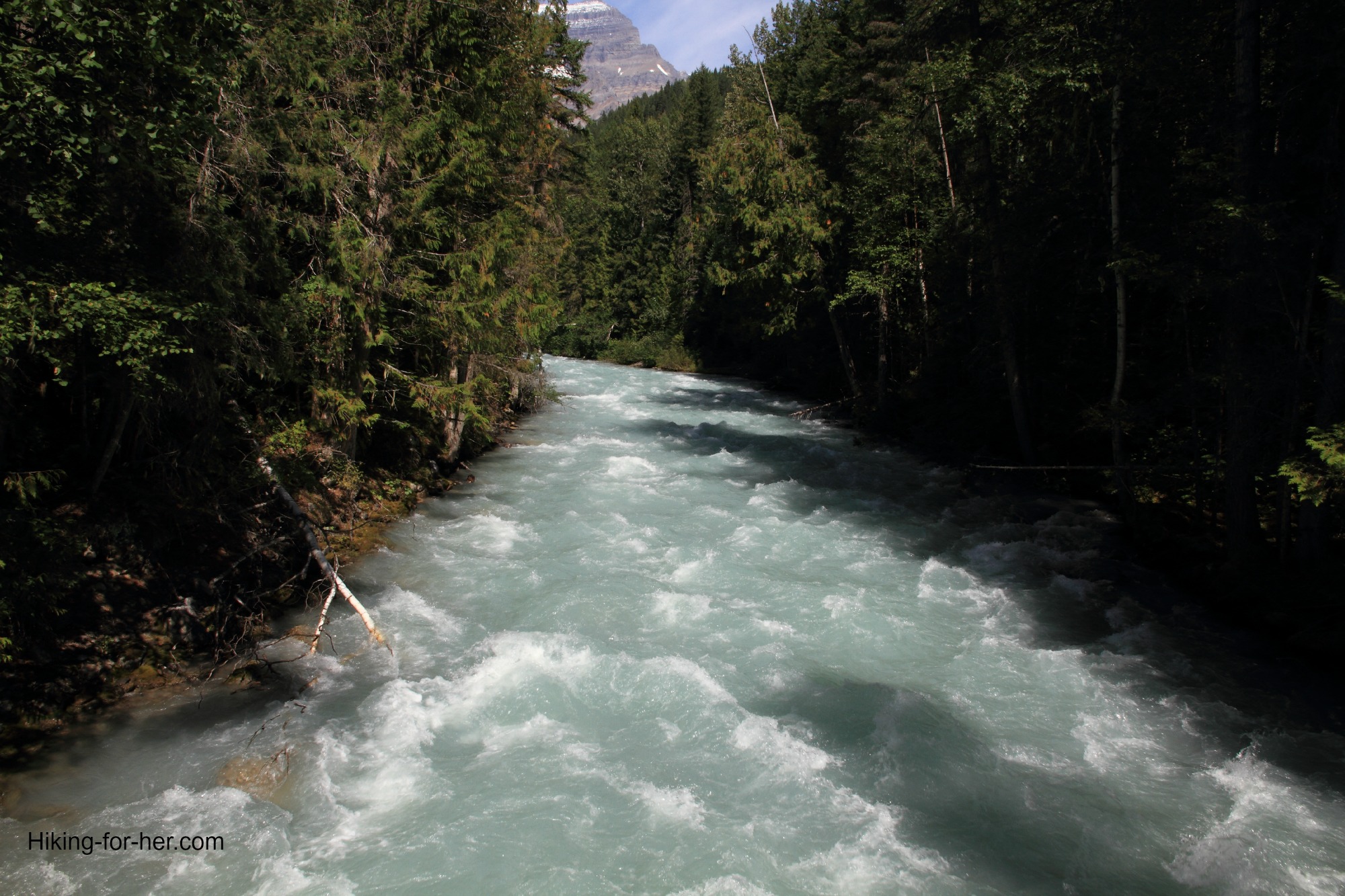 Is your gut all churned up like the Robson River, B.C.?
Is your gut all churned up like the Robson River, B.C.?
How to handle severe
digestive upset on the trail
What to do if you're in the middle of a hiking trip and your digestive system is severely upset?
That question is beyond what I can answer, since I'm not a medical doctor.
But there are a few general tips to keep in mind.
Blood in your stool could be telling you about a bacterial infection which has invaded the lining of your gastrointestinal tract.
Certain bacteria & parasites are notorious for causing dysentery (a fancy word for bloody poop).
You won't be able to determine "who" is the culprit while you are out on the trail, but you will want to get to a health care provider soon to have that sorted out for you.
- Sometimes antimicrobial medications are needed, but sometimes they
are not a good idea because they make the signs and symptoms worse.
- It's important to get an expert opinion on this.
If you're not close to health care & won't be for several days, curtail your food intake until you can identify what might have gotten contaminated.
- Check any fresh foods for signs of spoilage or funny odors.
- Check all packaged foods for a containment breach, and avoid eating any that smell or taste weird.
- Boil all drinking water for at least 5 minutes if you can spare the fuel. You can also put your drinking water in direct sunlight for several hours to kill microbes.
- Stick to bland foods like oatmeal or crackers for your hiking nutrients for at least 12 hours, allowing your digestive system time to recover.
- Be sure to replenish your body's water by frequent sips of treated water.
- High fiber foods (see above) can slow down your water loss, if you can manage to chew them.
Short term, it's better to deprive yourself of hiking nutrients than to push your already upset system into overdrive trying to digest heavy, spicy meals.
Bigger troubles
need to be dealt with ASAP
If you are getting systemic trouble signs such as headache, fever, nausea, or fatigue, you're going to have to stop and rest, possibly even take a rest day & establish a base camp.
- Don't argue with yourself about this, just do it.
- Long trails like the AT and PCT are littered with wounded warriors who tried to soldier on, only to lose the battle with the gut.
If you inconvenience your hiking partners, don't worry. Their turn for inconvenient episodes will come, one way or the other!
Tip:
If you do receive antibiotics when you get home, be sure to recolonize your digestive system with the "good guys" (probiotics) which are normally found in your gut but which die right along with the trouble makers.
- They don't call those powerful drugs "anti - life" for nothing!
Ways to re-establish peace within
And ensure that your hiking nutrients
are being absorbed
Probiotic supplements that you can chew, swallow, or add to food are an easy way to re-establish, and maintain, a healthy gut environment.
This is not medical advice, just common sense.
Pro means in favor of, and biotic means life, so this is a good idea on many levels.
Things to look for in good probiotics:
- A diversity of microbes, including Lactobacillus and Bifidobacterium.
- No other ingredients that will give you digestive upsets, including gluten and lactose;
- High numbers of CFUs (colony forming units), indicating lots and lots of microbes to populate your intestinal tract;
- Acid resistant packaging, so when you swallow the capsule it passes through your acidic stomach without damaging the contents.
Expect to pay extra for all of these good qualities.
The really cheap probiotics might have a lower CFU count than advertised, because the microbes are non-viable (not capable of binary fission, so won't be able to do fast and effective colonization).
Tip:
Store your probiotics in the frig at home, and add them to your pack at the last minute. This habit prevents heat or dehydration damage.
Would you rather
rely upon your food
to give you good bugs?
Some
yogurt
products have these added in as part of the production process. Read the
label to be sure you're getting a wide range of the good bugs (and good luck with pronouncing those long Latin names).
- Please don't avoid yogurt if you're lactose intolerant - try coconut, soy, and rice milk based fermented products which are enhanced with good bacteria.
Just to be sure, you might want to consider prebiotics, which create a healthy environment (FOS, or inulin) for the gut bacteria to multiply quickly to re-establish and maintain harmony and bliss in your gut.
- Asparagus is a great food
for providing the fiber and sugars these tiny hard workers need.
- Or you can swallow a tablet or pack some prebiotic powder. Easy to manage on the trail!
Combo options
There are some products which combine probiotics with prebiotics, meaning you will only have to swallow once to do your gut good.
These are a great idea even if you don't experience digestive upset at home. Trail food is notorious for binding you up, creating gas, messing with your normal bowel movement cycle, and more.
And here's a product to investigate as one part of your plan to achieve a stronger body and peaceful digestive system.
Pay attention to pain
Another thing to consider is pain.
If your abdominal muscles are cramping, there could be bacterial toxins signalling your body to swing into action and expel the invaders.
- Accept the fact that you will be spending more time behind the bushes. I sincerely hope there are some wherever you find yourself.
- Be sure your hygiene kit is with you at all times: moist antibacterial wipes, plastic ziplocks to dispose of those wipes, and antibacterial hand washing supplies. Keep your trowel (for digging a suitable cat hole) in a separate bag.
Why are you cramping?
Not a trivial question!
You'll need to distinguish between cramps caused by gas production versus cramps related to impending diarrhea (and rule out menstrual cramps, if applicable).
- Gas cramps can be alleviated by getting into the fetal position and gently touching your knees to your chest, using your arms if necessary.
- This encourages the release of the gas from your body, without undue straining.
- Try this technique outside of your tent, unless (or even when) you're hiking solo. You know why!
Strong word of caution:
If it's diarrhea, pay attention to hand washing hygiene afterward. You don't want to share the infection with anyone else, or reinfect yourself.
If you're producing a lot of gas, where is it going?
- Belching (burping) is one way gas leaves the body.
- Flatulence (breaking wind, passing gas, and lots of other more colorful terms) is another.
- Staying trapped in your abdomen (bloating) is another possibility.
The message here is that what you are eating is not being fully digested.
Get to the bottom of it. (That was not an intentional pun. Sometimes things just slip out.)
(I'll stop now.)
How?
Keep reading.
Keep a food diary
Keep a hiking nutrients log a.k.a. a food diary of what you ate, and when, on your hiking trip.
- Another great use of your trail journal.
Then play "scientist" by making one change in your diet at a time.
Systematic = scientific.
Examples:
- Substitute whole wheat bread for the rye bread,
- leave the
cheese off the sandwich, or
- skip the high fat pastry or donut at the trail head.
Try to keep all the important hiking nutrients without causing symptoms.
Do this detective work until you can identify what's causing the digestive problems.
C'mon! Isn't symptom free hiking worth it? You know you want to feel great on the trail, rather than being bothered by gas and cramping.
Your tent partners might appreciate it, too. (Just sayin')
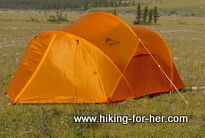 No explosions, please
No explosions, please
Another big clue
to digestive unhappiness
Which brings up another clue:
odors associated with your gas.
A sulfur smell might be indicating that your protein sources are not being digested.
- What are your protein sources?
- What do you combine with your protein (dairy products like cheese, spicy sauces, etc.)?
Time to mix it up a little, until the gas goes away!
When you get home, ask your health care provider about checking into how much acid you're producing in your stomach.
Here's why:
Stomach (gastric) acid is the first thing to attack and break down proteins. If your stomach pH is too high (not enough acid), undigested protein is passing into the intestine, and you're not getting the full benefit of the protein you're ingesting.
In essence, highly valuable hiking nutrients are being sent through your body without benefiting you.
But they definitely benefit the bacteria that digest them, producing methane gas as a by product.
Note: Everyone produces methane gas. But excess amounts with a strong sulfur smell?
- Not good.
Hiking nutrients
& emotions
Your emotional state also affects your hiking nutrient absorption.
You have lots of nerve fibers throughout your body, with plenty of them devoted to the digestive organs.
- It's called the "enteric" nervous system, and many people call it the "gut brain."
Eating when you are stressed or angry will be reflected in how your abdomen feels within a few minutes of chewing and swallowing.
Your gut is telling you to NOT eat when you're emotional, because your blood supply is being directed away from your digestive organs.
You might also experience acid reflux, where the stomach contents are splashing back into the esophagus (food tube) area. That hurts!
And in the long run, it is a dangerous condition for your esophagus and stomach.
- GERD, or gastroesophageal reflux = painful
Vigorous exercise after eating?
Maybe not
Stomping off down the trail right after eating is not a great move, either.
The body diverts its blood to the digestive organs so your hiking nutrients can be processed efficiently. Makes sense, right?
But now, by charging off down the trail right after lunch, you're asking for increased blood flow to the skeletal muscles.
This throws off the normal balance (homeostasis), and you will feel an uneasy sensation in your abdomen.
You might experience muscle cramping, too.
- Avoid the whole fiasco by resting for 15 or 20 minutes after eating a meal, and then tighten up your boot laces and get back on the hiking trail or route.
- If you've experienced something exciting (like spotting a bear) or upsetting (like an injury), wait for 30 minutes before snacking.
One more fun fact
about your digestive system
Your immune cells have a strong presence here.
So an inflamed or upset gut will weaken your immunity, leaving you vulnerable to parasites and other microbial pathogens that you could pick up from untreated surface water, unclean hands that prepare food, or contact with soil.
Always seem to have
tummy troubles?
If you have chronic gastrointestinal (GI) issues, please see a health care provider to rule out other health problems.
These little postcards are being sent to get your attention before something major develops.
My best advice: When your body talks to you, listen!
And Round Two of best advice:
Respond to the whispers before they turn into roars.
Use your powerful intuition
on the trail
On the trail, your best ally is your intuition.
If you feel "off", sit down immediately and tune into that feeling.
- What did you just eat?
- Eat within a few hours?
- Yesterday?
The incubation times for various food borne infections can vary between a few hours and a few days.
Consider all of your food & water as suspicious until you can piece together what might be making you sick.
- Where are you getting your water?
If you're base camping, you've segregated your latrine (bathroom) area from your water source, right?
- How are you treating your water before you consume it? Maybe you need longer boiling times, or your filter is cracked or dirty.
- Who is preparing the food? Is proper hand hygiene being followed?
- Are the eating utensils cleaned adequately? Is soap rinsed off, or could it be giving you the runs?
Consider the possibility that you are coming down with a viral infection, having nothing to do with your food or water supply.
Anti inflammatory relief from your 1st aid kit, probiotics, more frequent rest breaks, and water will help you through this while you get back to the trail head.
Or you might need a rest day (a zero day for thru hikers).
- Hopefully you built in a cushion of time when you planned your trip.
Let's be blunt
Don't fight Mother Nature unless you really have to.
Human imposed deadlines can wreak havoc with your body.
- Taking anti diarrheal agents buy you trail time, but may drive an infection deeper into your body.
- Continuing to hike in a depleted state is asking your immune system to go way out on a limb to protect you in a weakened state.
It's a tough call sometimes: you want to suppress or ignore the problem so you can get back home and into a medical setting.
But if it's not a severe problem, and you can grant yourself some space and time, you might want to work with the admittedly inconvenient and unpleasant process, without suppressing the symptoms.
Only you can make that decision, after considering all the facts and constraints in your situation.
Don't let peer pressure sway your decision. Listen to your body and make the best choice possible under the circumstances.
One more thought...
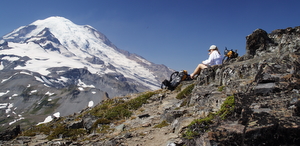 Use hiking as a way to a peaceful mind
Use hiking as a way to a peaceful mindOne more possibility to consider when digestive issues arise:
Are you carrying along emotional turmoil, which is showing up as turmoil in your gut?
Ask yourself:
- Do I really enjoy my hiking companions?
- Do I share a mutually beneficial hiking style with them, or am I forced to compromise?
- Are my hiking destinations satisfying or too challenging?
- Am I worried about the people or pets or projects I left at home?
Make a sincere effort to let any tensions and turmoil go, as in eliminate it (ok, cheap gut pun).
Your gut is charged with the responsibility of eliminating waste and toxins from your body.
So follow its lead:
Let. It. Go.
The problem, whatever it is, will be waiting for you when you get home. Don't squander precious trail time on it now.
And is it possible that it's not a matter of hiking nutrients, but soul & spirit nutrients, that you're craving?
Like alone time, as in hiking solo?
Or nature therapy: food for thought!
Hikers with special
digestive challenges
If you find yourself in any of the following categories, please take extra time to plan your hiking menus and trail snacks carefully.
- If your gall bladder is a thing of the past, pay attention to your protein/fat ratios.
- If you're a nursing mother, you'll need extra calories and a nutrient dense menu.
- If you're an older hiker, your gut may not be as efficient at processing large amounts of food, so perhaps small snacks and several smaller meals is the way to go while backpacking.
- If you have dental problems or oral ulcers, eating is going to be more complicated.
- If you're a thru hiker trying to beat the clock, food you can scarf down as you move has to have good digestibility without upsetting your stomach.
The key to meeting any of these challenges as a hiker is to try out your trail food at home, where you have the convenience of a bathroom and a kitchen.
Record what works well, and especially make a note of what to avoid.
- Sometimes your memory fails when you're standing in the grocery store or in front of the backpacking food display at REI!
Thanks!
Thanks for hanging in there with me through poop, pain, gas and bad puns.
- Because sometimes you've gotta cry before you can laugh, right?
Please let me know if you have questions about what you've read about hiking nutrients and digestion. I can point you toward some resources, or give you more ideas to identify food sensitivities or digestive problems.
Just remember, I'm not giving medical advice.
It's up to you to do your own background research and consult with medical authorities!
But I have a gut feeling that you already knew that :)
Home page > Hiking Nutrition >
Hiking Nutrients
If you purchase any of the things I recommend on this website using one of the affiliate links, it costs you nothing extra.
- Only what works is recommended to you, because we're all in this hiking thing together, right?
You also help Hiking For Her to keep publishing the best hiking tips for everyone to read, for free.
Thanks for your support!
And Happy (Non-Digestive Woes) Trails.

